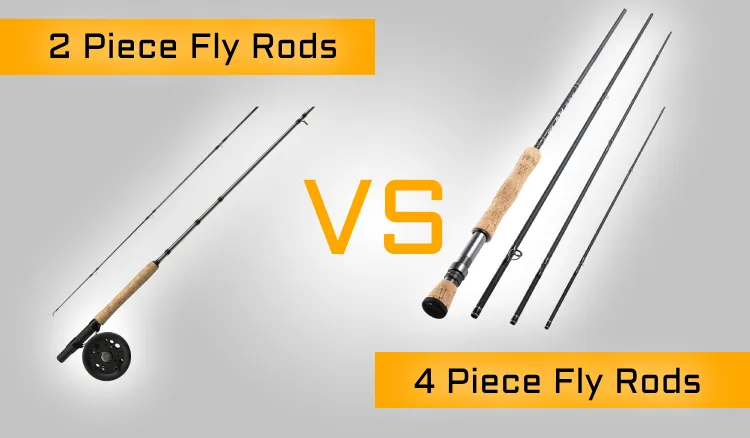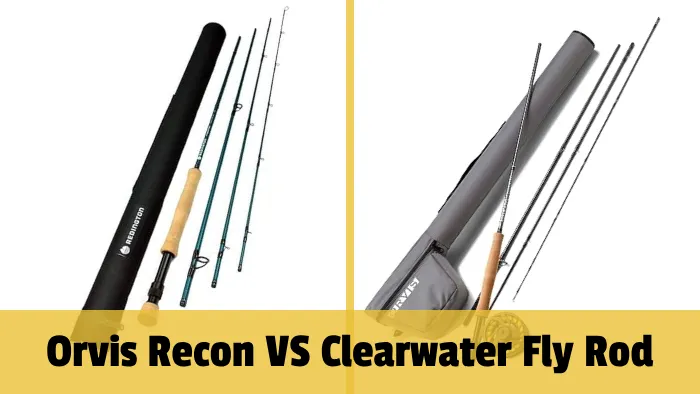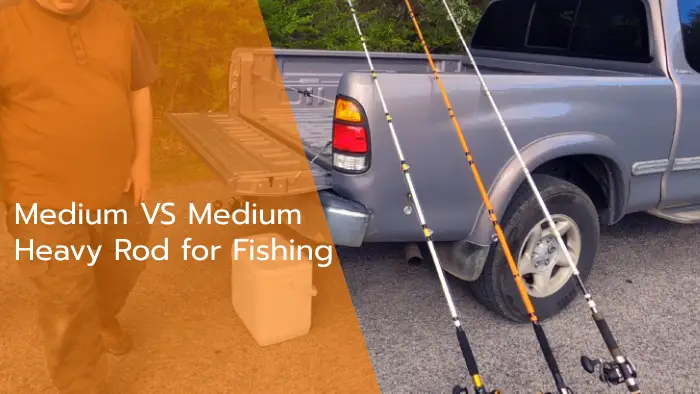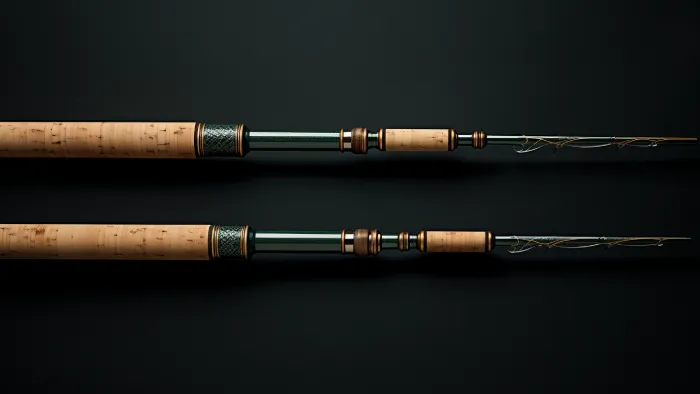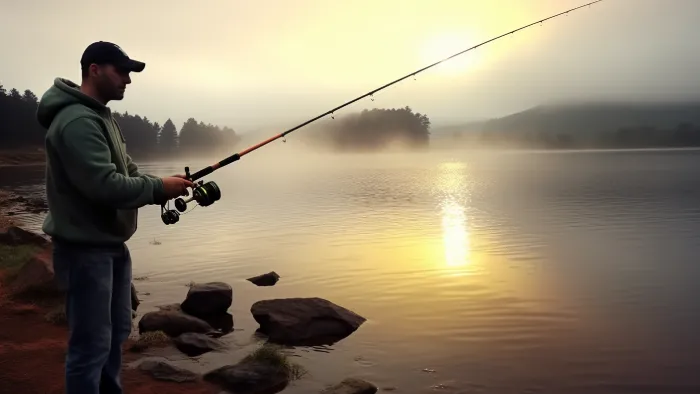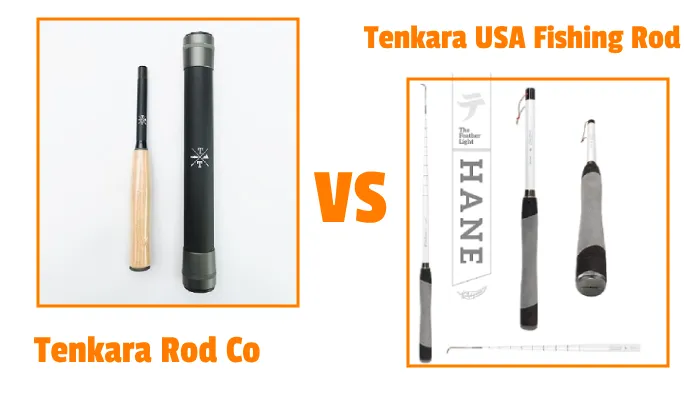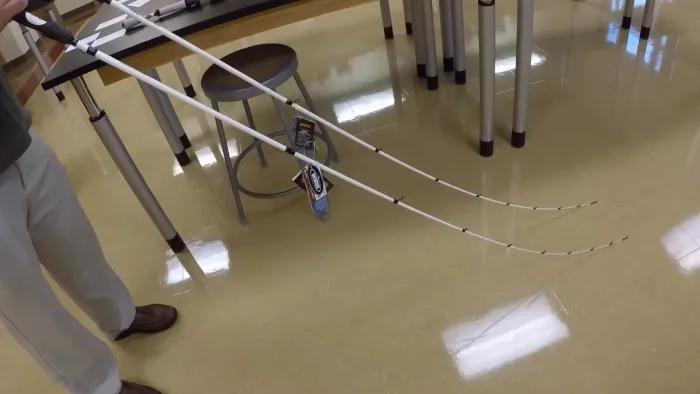2 Piece vs 4 Piece Fly Rods: 6 Differences During Fishing
You find yourself standing by the sparkling river, the sun glinting off the water as you prepare to cast your line. But wait, you pause and consider a crucial decision: should you choose a 2 piece or 4 piece fly fishing rod?
A 4 piece rod is much easier to transport, as it can be broken down into smaller sections that fit into a compact carrying case. This makes it ideal for traveling or hiking to remote fishing spots. Conversely, a 2 piece rod is generally easier to set up and take down, which can be a time-saver on the water.
This article will look into the differences between these two rod types, exploring their lengths, portability, and suitability for beginners. So, let’s dive in and discover the rod that will elevate your fishing prowess to new heights.
6 Differences Between 2 Piece and 4 Piece Fishing Rods
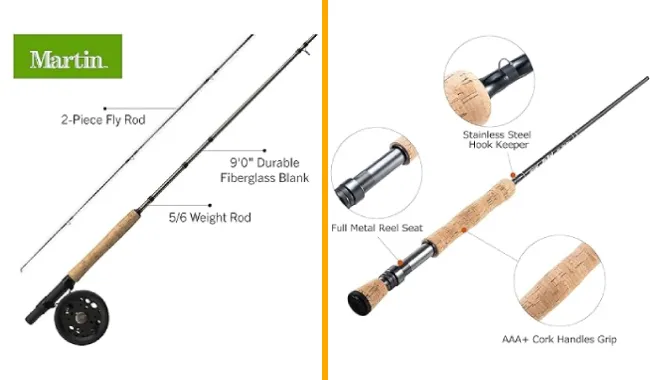
When choosing between a 2 piece and 4 piece fly rod for fishing, there are a few key points to consider.
- Portability and travel
- Ferrule loosening
- Feel and action
- Maintenance and repairs
- Reel and accessory storage
- Nostalgia and personal preference
Here are a few more details about each of these aspects.
No 01: Portability and Travel
One of the most noticeable differences between 2 piece and 4 piece fly fishing rods is their portability and convenience for travel.
The longer length when assembled of 2 piece rods makes them less convenient for travel as they often require specialized cases or careful handling. This is because they are more challenging to fit into compact spaces such as backpacks and carry-on bags.
In contrast, 4 piece rods are explicitly designed with portability and ease of transport in mind. They are easier to break down into shorter sections, making them ideal for travel and storage in compact cases or backpacks.
In addition, 4 piece fly fishing rods are generally more comfortable to transport through airports. Due to airline regulations, carrying 2 piece rods on planes is difficult as they are likely to exceed the maximum size. The 4 piece rods, when broken down into separate sections, comfortably fit within the regulation limits.
No 02: Ferrule Loosening
One significant difference between the 2 piece and 4 piece fly fishing rods is the tendency of one of them to experience ferrule loosening issues.
2 piece rods are less prone to ferrule loosening during fishing, providing a consistent and reliable performance. Meanwhile, Some anglers have reported ferrule loosening issues with certain 4 piece rods, which can affect the rod’s stability during casting.
However, it is essential to note that modern designs have significantly reduced this problem. So, while it is a genuine concern, it is not as significant of an issue as before.
To ensure longevity and prevent loosening of ferrules when using a 4 piece fly fishing rod, users must take care to align and firmly screw the individual sections. By doing so, anglers can ensure a stable and reliable fly fishing experience, just like it will in a 2 piece rod.
No 03: Feel and Action
You’ll notice that the feel and action of 2 piece and 4 piece rods can vary based on the specific rod model and brand. When it comes to fly fishing rods, the feel and action are crucial factors that affect your overall fishing experience.
With advancements in technology, 4 piece rods have come a long way and can now provide similar performance to their 2 piece counterparts. The modern blanks used in 4 piece rods have greatly reduced the noticeable differences in feel and action.
This means you can expect a smooth and responsive casting experience with both rods. However, it’s important to note that certain rod models and brands may still have slight variations in terms of feel and action.
Conversely, 2 piece rods offer the traditional and classic feel that many anglers are familiar with. This can be a great benefit for experienced anglers who may prefer the more traditional rod experience. Also, 2 piece rods have fewer parts to worry about, which means less chance of losing a piece while fishing.
No 04: Maintenance and Repairs
Regarding maintenance and repairs, it’s important to consider the number of ferrules and sections you’ll have to manage.
With 2 piece rods, you have the advantage of simplicity. There are fewer components to worry about, making maintenance a breeze. If a ferrule gets loose or a section breaks, it’s easy to fix or replace.
On the other hand, 4 piece rods may seem more daunting, but they are still manageable. While there may be more ferrules and sections, the maintenance and repair process is similar. Manufacturers often offer cost savings for 4-piece rods, so any repairs or replacements won’t break the bank.
With a little knowledge and experience, you can keep your fly fishing rod in great shape, no matter the number of pieces.
No 05: Reel and Accessory Storage
When storing your reels, lines, and accessories, the type of rod you choose can make a significant difference. If you opt for a 2 piece rod, you may need to consider separate storage solutions for these components, as they are not typically accommodated within the rod case.
However, with a 4 piece rod, you can find cases specifically designed to include reels, fly boxes, and leader materials compartments. This all-in-one storage solution offers convenience and ensures that all your essential gear is organized and protected.
No 06: Nostalgia and Personal Preference
Some anglers have a deep emotional attachment to the traditional aspect of fly fishing. Connecting with the sport’s history and using a rod used for generations can be incredibly satisfying. These anglers value the nostalgia that comes with a 2 piece rod and believe it adds to the overall experience of fly fishing.
Additionally, personal preference plays a significant role in this decision. Some anglers simply prefer the feel and weight distribution of a 2 piece rod, finding it more comfortable and easier to handle.
Ultimately, the choice between a 2 piece and a 4 piece rod depends on your personal connection to tradition and your individual preferences in terms of performance and convenience.
Comparison Table Between 2 Piece and 4 Piece Fly Fishing Rods
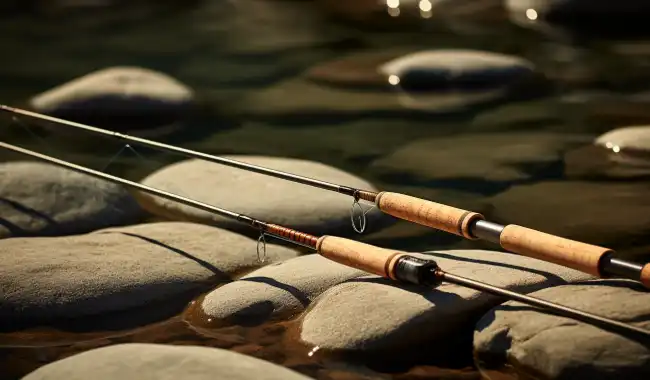
| Aspect | 2 Piece Fly Fishing Rods | 4 Piece Fly Fishing Rods |
| Portability and Travel | Less convenient for travel, longer design | Designed for easy transport, breaks into 4 pieces |
| Nostalgia and Preference | May appeal to those with a nostalgic attachment | Increasingly popular due to convenience and design |
| Ferrule Tightness | Less prone to ferrule loosening during use | Some models may experience ferrule issues |
| Manufacturing Cost | Simpler manufacturing may lead to affordability | Potential for higher production costs |
| Performance Consistency | Generally offers consistent performance | Designed for consistent performance |
| Specialized Rod Models | Available for specific fishing environments | Widely available across various rod types |
| Storage on Fishing Trips | Suitable for anglers with dedicated storage | Convenient for storage during fishing trips |
| Feel and Action | Subtle differences in feel and action may exist | Improved action and feel, close to 2 piece |
| Repair and Replacement | Replacement may involve an entire blank | Easier and cost-effective repair or replacement |
| Custom Rod Cases | Requires custom cases for longer transport | Fits comfortably in standard rod tubes |
How long is a 2 piece fly rod?
If you’re wondering, a 2 piece fly rod typically measures between 6ft to 9ft in length. This length range suits various fishing situations and accommodates different casting styles and preferences.
A 6ft rod offers a shorter, more compact option, ideal for small streams and tight spaces where precision casting is crucial.
On the other hand, a 9ft rod provides greater reach and power, making it suitable for larger bodies of water and casting longer distances.
How long is a 4 piece fly rod?
To find the length of a 4-piece fly rod, you’ll need to look at the specifications provided by the manufacturer or consult a reputable fishing guide. Typically, 4-piece fly rods come in lengths of either 9ft or 10ft.
The length of the rod plays a crucial role in determining the casting distance and accuracy. A longer rod, such as a 10ft, can provide greater leverage and reach when casting. This can be beneficial when fishing in larger bodies of water or targeting species requiring longer casts.
On the other hand, a 9ft rod is more maneuverable and easier to handle in tight spaces or when fishing in smaller streams. Ultimately, the length of the 4 piece fly rod you choose will depend on your preference and the type of fishing you plan to do.
How many pieces should a fly rod be?
When choosing a fly rod, consider how many sections it has to ensure it is convenient to transport and assemble. A 4-piece rod is highly recommended for its portability and ease of use.
With four separate sections, this type of rod can be broken down into smaller pieces, making it easier to fit into a travel case or backpack. It also allows for quick and hassle-free assembly when you’re ready to fish.
Additionally, a 4-piece rod offers the advantage of being more durable than a 2-piece model. The multiple sections distribute the stress more evenly, reducing the risk of breakage or damage.
What size fly rod is ideal for beginners?
For beginners, the ideal rod size would be a 9-foot with a 5-weight and two sections, providing you with versatility and ease of use. This size is considered universal and can be used in most fishing situations.
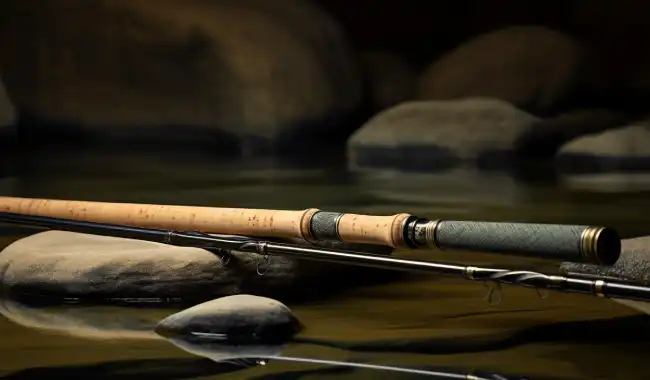
The 9-foot length gives you enough reach to cast accurately and control the line effectively. The 5-weight designation means that the rod has enough power to handle a variety of fish species while still being light enough to provide a delicate presentation.
Having a rod with two sections also makes setting up easier, especially for beginners needing more experience assembling and disassembling rods. This size and configuration offer beginners a great starting point for their fly-fishing journey.
Fishing experts in different states such as Oregon, Washington, Pennsylvania, Idaho and more recommend two-piece sets for beginners because of their ease of assembly and portability. When you want to fly fish in Oregon or other locations, you can use the 2-piece rod easily.
2 Piece or 4 Piece Fly Rods: Exploring the Fly Fishing Rod Dilemma
In the dynamic realm of fly fishing, where the pursuit of the perfect catch is an ever-evolving art, the choice between 2- and 4 piece fly fishing rods remains a deeply personal one.
As we’ve discovered, each option comes with its distinct advantages. Whether it’s the portability and convenience of 4-piece rods for adventurous travelers or the timeless appeal of 2-piece rods cherished for their nostalgic charm.
Ultimately, the decision between these two configurations hinges on many factors, including angling style, specific fishing environments, and individual preferences.
Regardless of the choice, what remains constant is the unbridled passion shared by fly fishing enthusiasts worldwide, united by their unwavering pursuit of the perfect cast and the thrill of landing that elusive fish.

